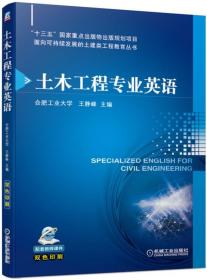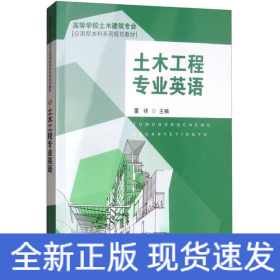
土木工程专业英语
全新正版现货
¥ 15.5 5.0折 ¥ 31 全新
库存2件
四川成都
认证卖家担保交易快速发货售后保障
作者吴轶 编
出版社武汉大学出版社
ISBN9787307159952
出版时间2018-09
装帧平装
开本16开
纸张胶版纸
定价31元
货号25324671
上书时间2024-07-04
- 在售商品 暂无
- 平均发货时间 15小时
- 好评率 暂无
- 最新上架
商品详情
- 品相描述:全新
- 正版全新
- 商品描述
-
【内容简介】:
本书系统地介绍了土木工程类专业英语的相关知识。
本书在充分体现全面性、新颖性、系统性和广泛适用性的基础上,注重对专业基础内容和前沿专业知识的关注,内容贴近教学实际,针对性强。本书既可以作为工程技术人员专业英语的参考书,又可以作为本科生、研究生教材与教师用书。
本书选材涉及土木工程概况、土木工程类别、土木工程材料、工程荷载及作用、结构构件类别、地下工程、桥梁工程、道路工程、工程抗震设计、隔震技术、建筑加固技术等方面,共分为13章,每章均由课文、生词和短语组成。在内容上,涉及工程材料、材料力学、理论力学、混凝土结构设计原理、钢结构设计原理、道路工程、结构抗震设计、建筑加固理论、土力学、基础工程等相关学科知识。
【目录】:
Chapter 1 Overview of Civil Engineering
1.1 Introduction of Civil Engineering
Section A The Origin of Civil Engineering
Section B What Is a Civil Engineer
1.2 The Importance of Civil Engineering
Section A The Role of Civil Engineering in Society
Section B Historic Civil Engineering Landmarks
References
Chapter 2 Types of Civil Engineering
2.1 Structural Engineering
Section A Introduction of Structural Engineering
Section B Basic Types of Structures
2.2 Bridge Engineering
2.3 Underground Engineering
Section A Introduction of Metropolitan Railway
Section B Introduction of Tunnel Engineering
2.4 Road Engineering
Section A Introduction of Road Engineering
Section B Maintenance of Road Engineering
References
Chapter 3 Materials of Civil Engineering
3.1 Concrete
Section A Introduction of Concrete
Section B Properties of Concrete
3.2 Steel
3.3 Masonry
References
Chapter 4 Loads and Actions in Civil Engineering
4.1 Dead Load and Live Load
4.2 Wind Load and Wind Damage
Section A Introduction of Wind Load
Section B Classification of Wind Load
Section C Horizontal Wind Loads and Roof Wind Loads on Structural Frames
Section D Wind for Components and Wind Damage
4.3 Earthquake Action and Damage
Section A Earthquake Action
Section B Earthquake Damage
4.4 Tsunami Damage to the Structure of Civil Engineering
Section A Tsunami Damage
Section B Tsunami Damage to Buildings
Section C Resistance of Tsunamis for Structures
References
Chapter 5 Members of Civil Engineering
5.1 Horizontal Forced Structural Members
Section A Introduction of Beam
Section B Forces within a Beam
Section C Shear Strength and Parameters
Section D Coupling Beams
Section E Flat Plates
Section F Behavior of Concrete Slabs
Section G Floor Framing Systems
5.2 Vertical Forced Structural Members
Section A Introduction of Column
Section B Increasing Compressive Strength
Section C High-strength Steel in Concrete Columns
Section D Confinement in Reinforced Concrete Columns
Section E Introduction of Concrete Structural Wall
Section F Behavior of Structural Wall
Section G Steel Plate Shear Walls
5.3 Arch
Section A Introduction of Arches
Section B Development of Arch Bridges
5.4 Truss
Section A Introduction of Truss
Section B Analysis of Internal Force
Section C Production and Installation of a Truss
References
Chapter 6 Basic Types of Engineering Structure
6.1 Reinforced Concrete Structures
Section A Application of Reinforced Concrete Structures
Section B Performance of Reinforced Concrete Structures
6.2 Steel Structure
Section A Introduction of Steel Structures
Section B Incheon International Airport
6.3 Classification of Steel Concrete Composite Structure
Section A Steel Concrete Composite Structure
Section B Concrete-filled Steel Tube Column
6.4 The Modern Complex High-rise Building Structure
Section A Performance-based Seismic Design
Section B Performance Objectives of PBSD
References
Chapter 7 Bridge Engineering
7.1 Introduction of Bridge Engineering
Section A History of Bridge
Section B London Millennium Footbridge
7.2 Classification of Bridge
Section A Rigid Beam and Cantilever
Section B Suspension and Arch
7.3 Design of Bridge
Section A Design of Bridge Structure
Section B Numerical Analysis of Bridge Structures
References
Chapter 8 Underground Engineering
8.1 Introduction of Underground Engineering
Section A Exploitation of Underground Space
Section B The Underground Strategy
8.2 Underground Tunnel Engineering
Section A Tunneling Risk
Section B A New Requirement of Tunneling
8.3 Development of Underground Space Structure
Section A Web-based Shield Tunnel Construction Information System
Section B Urban Underground Space Planning
References
Chapter 9 Road Engineering
9.1 Urban Road
Section A Introduction of Urban Road
Section B Development of Road Engineering
9.2 Freeway Engineering
Section A Design of Freeway
Section B Development of Freeway
References
Chapter 10 Foundation Engineering
10.1 Introduction of Foundation
Section A A Shallow Foundation
Section B Types of Pile Foundation
10.2 The Principles of Foundation Design
Section A What Is Foundation Design
Section B Causes of Settlement
References
Chapter 11 Performance-based Seismic Design
11.1 Introduction of Performance-based
Seismic Design
Section A The Origin of Performance-based Seismic Design
Section B Development of Performance-based Seismic Design
11.2 Structural Seismic Demand and Seismic Capacity
Section A Structural Seismic Demand
Section B Structural Seismic Capacity
11.3 Loss Evaluation in Earthquake Events
Section A Methodologies of Earthquake Economic Loss Estimate
Section B Earthquake Disaster References
Chapter 12 Isolation and Energy Dissipation Damper Technology
12.1 Seismic Isolation Technology
Section A Introduction of Seismic Isolation Technology
Section B Functions of Seismic Isolation Technology
12.2 Energy Dissipation System
Section A Introduction of Energy Dissipation System
Section B Classification of Dampers References
Chapter 13 Retrofitting Techniques for
Seismic Strengthening
13.1 Outline of Retrofitting Techniques for Seismic Strengthening
Section A Origin of Retrofitting Techniques for Seismic Strengthening
Section B The Importance of Retrofitting Techniques for Seismic Strengthening
Section C Problems of Retrofitting Techniques for Seismic
Strengthening
13.2 Types of Retrofitting Techniques for Seismic Strengthening
Section A Classification of Retrofitting Techniques for Seismic Strengthening
Section B Introduction of Fibre Reinforced Polymer
13.3 Applications of Materials in
Seismic Strengthening
Section A Applications of Composite Materials
Section B Steel Plates in Seismic Strengthening
References
【作者简介】:
吴轶,博士,广州大学教授。2004年获华南理工大学结构工程专业工学博士学位,2005年晋升副教授,201O年晋升教授。长期从事高层建筑结构抗震、结构减震控制及城市防灾减灾方面的教学、科研工作。主持与主要参加10余项国家自然科学基金、省部及厅局项目。在Engineering struchures、《工程力学》、《计算力学学报》、《土木工程学报》等刊物上发表40余篇学术论文,出版教材2部,参编教材3部。
相关推荐
— 没有更多了 —






















以下为对购买帮助不大的评价